TTI101FC: Reflective Journal on the Evolution of Tourism Sector
VerifiedAdded on 2023/06/15
|14
|3898
|77
Journal and Reflective Writing
AI Summary
This reflective journal delves into the travel and tourism industry, highlighting its evolution, emerging trends, and interrelationships. It covers various aspects of tourism, including domestic, inbound, and outbound travel, and examines the industry's development and the changes affecting travel patterns. The journal discusses the economic impact of tourism, particularly in Australia, and explores the influence of technology, such as mobile phones, on travel planning. It also addresses the decline of generic holidays and the rise of personalized travel experiences like 'living like a local' and 'bleisure' trips. Furthermore, the journal analyzes the interrelationships between different sectors within the tourism industry, such as tour operators, travel agents, transport operators, and accommodation providers, illustrating how these entities work together to meet customer expectations. Finally, the journal outlines the stages of a customer's journey, from planning and booking to anticipating and experiencing the destination.

(student Details)
Paraphrase This Document
Need a fresh take? Get an instant paraphrase of this document with our AI Paraphraser
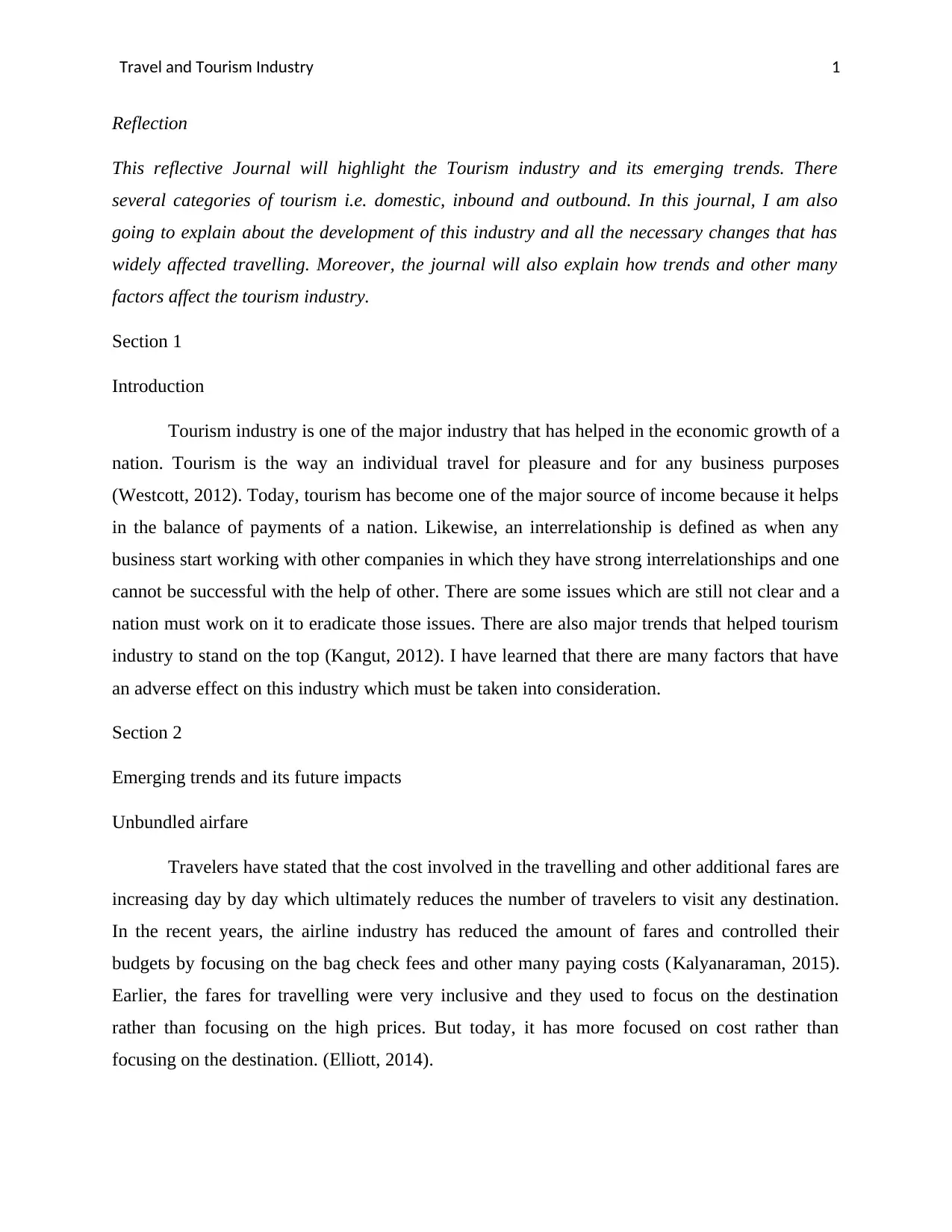
Travel and Tourism Industry 1
Reflection
This reflective Journal will highlight the Tourism industry and its emerging trends. There
several categories of tourism i.e. domestic, inbound and outbound. In this journal, I am also
going to explain about the development of this industry and all the necessary changes that has
widely affected travelling. Moreover, the journal will also explain how trends and other many
factors affect the tourism industry.
Section 1
Introduction
Tourism industry is one of the major industry that has helped in the economic growth of a
nation. Tourism is the way an individual travel for pleasure and for any business purposes
(Westcott, 2012). Today, tourism has become one of the major source of income because it helps
in the balance of payments of a nation. Likewise, an interrelationship is defined as when any
business start working with other companies in which they have strong interrelationships and one
cannot be successful with the help of other. There are some issues which are still not clear and a
nation must work on it to eradicate those issues. There are also major trends that helped tourism
industry to stand on the top (Kangut, 2012). I have learned that there are many factors that have
an adverse effect on this industry which must be taken into consideration.
Section 2
Emerging trends and its future impacts
Unbundled airfare
Travelers have stated that the cost involved in the travelling and other additional fares are
increasing day by day which ultimately reduces the number of travelers to visit any destination.
In the recent years, the airline industry has reduced the amount of fares and controlled their
budgets by focusing on the bag check fees and other many paying costs (Kalyanaraman, 2015).
Earlier, the fares for travelling were very inclusive and they used to focus on the destination
rather than focusing on the high prices. But today, it has more focused on cost rather than
focusing on the destination. (Elliott, 2014).
Reflection
This reflective Journal will highlight the Tourism industry and its emerging trends. There
several categories of tourism i.e. domestic, inbound and outbound. In this journal, I am also
going to explain about the development of this industry and all the necessary changes that has
widely affected travelling. Moreover, the journal will also explain how trends and other many
factors affect the tourism industry.
Section 1
Introduction
Tourism industry is one of the major industry that has helped in the economic growth of a
nation. Tourism is the way an individual travel for pleasure and for any business purposes
(Westcott, 2012). Today, tourism has become one of the major source of income because it helps
in the balance of payments of a nation. Likewise, an interrelationship is defined as when any
business start working with other companies in which they have strong interrelationships and one
cannot be successful with the help of other. There are some issues which are still not clear and a
nation must work on it to eradicate those issues. There are also major trends that helped tourism
industry to stand on the top (Kangut, 2012). I have learned that there are many factors that have
an adverse effect on this industry which must be taken into consideration.
Section 2
Emerging trends and its future impacts
Unbundled airfare
Travelers have stated that the cost involved in the travelling and other additional fares are
increasing day by day which ultimately reduces the number of travelers to visit any destination.
In the recent years, the airline industry has reduced the amount of fares and controlled their
budgets by focusing on the bag check fees and other many paying costs (Kalyanaraman, 2015).
Earlier, the fares for travelling were very inclusive and they used to focus on the destination
rather than focusing on the high prices. But today, it has more focused on cost rather than
focusing on the destination. (Elliott, 2014).
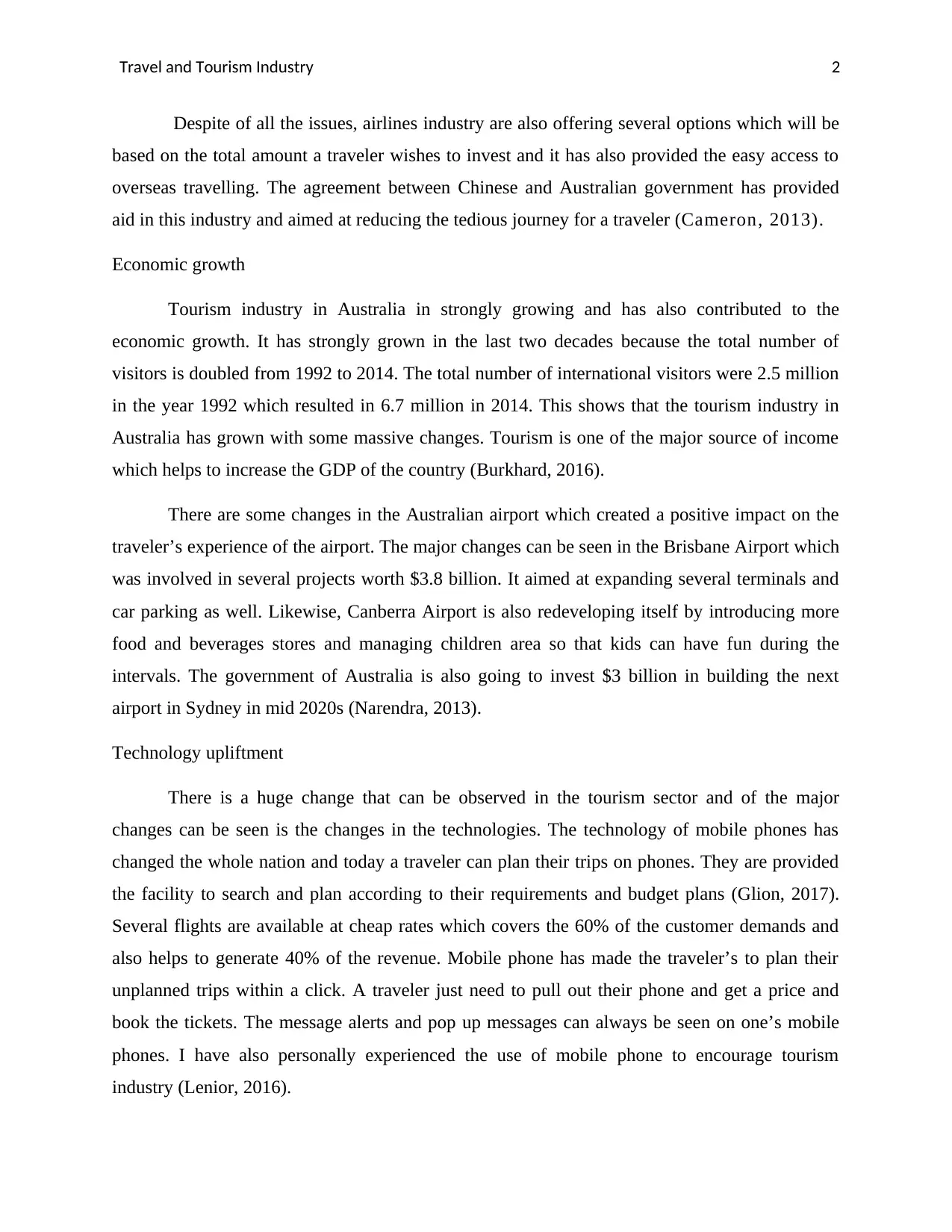
Travel and Tourism Industry 2
Despite of all the issues, airlines industry are also offering several options which will be
based on the total amount a traveler wishes to invest and it has also provided the easy access to
overseas travelling. The agreement between Chinese and Australian government has provided
aid in this industry and aimed at reducing the tedious journey for a traveler (Cameron, 2013).
Economic growth
Tourism industry in Australia in strongly growing and has also contributed to the
economic growth. It has strongly grown in the last two decades because the total number of
visitors is doubled from 1992 to 2014. The total number of international visitors were 2.5 million
in the year 1992 which resulted in 6.7 million in 2014. This shows that the tourism industry in
Australia has grown with some massive changes. Tourism is one of the major source of income
which helps to increase the GDP of the country (Burkhard, 2016).
There are some changes in the Australian airport which created a positive impact on the
traveler’s experience of the airport. The major changes can be seen in the Brisbane Airport which
was involved in several projects worth $3.8 billion. It aimed at expanding several terminals and
car parking as well. Likewise, Canberra Airport is also redeveloping itself by introducing more
food and beverages stores and managing children area so that kids can have fun during the
intervals. The government of Australia is also going to invest $3 billion in building the next
airport in Sydney in mid 2020s (Narendra, 2013).
Technology upliftment
There is a huge change that can be observed in the tourism sector and of the major
changes can be seen is the changes in the technologies. The technology of mobile phones has
changed the whole nation and today a traveler can plan their trips on phones. They are provided
the facility to search and plan according to their requirements and budget plans (Glion, 2017).
Several flights are available at cheap rates which covers the 60% of the customer demands and
also helps to generate 40% of the revenue. Mobile phone has made the traveler’s to plan their
unplanned trips within a click. A traveler just need to pull out their phone and get a price and
book the tickets. The message alerts and pop up messages can always be seen on one’s mobile
phones. I have also personally experienced the use of mobile phone to encourage tourism
industry (Lenior, 2016).
Despite of all the issues, airlines industry are also offering several options which will be
based on the total amount a traveler wishes to invest and it has also provided the easy access to
overseas travelling. The agreement between Chinese and Australian government has provided
aid in this industry and aimed at reducing the tedious journey for a traveler (Cameron, 2013).
Economic growth
Tourism industry in Australia in strongly growing and has also contributed to the
economic growth. It has strongly grown in the last two decades because the total number of
visitors is doubled from 1992 to 2014. The total number of international visitors were 2.5 million
in the year 1992 which resulted in 6.7 million in 2014. This shows that the tourism industry in
Australia has grown with some massive changes. Tourism is one of the major source of income
which helps to increase the GDP of the country (Burkhard, 2016).
There are some changes in the Australian airport which created a positive impact on the
traveler’s experience of the airport. The major changes can be seen in the Brisbane Airport which
was involved in several projects worth $3.8 billion. It aimed at expanding several terminals and
car parking as well. Likewise, Canberra Airport is also redeveloping itself by introducing more
food and beverages stores and managing children area so that kids can have fun during the
intervals. The government of Australia is also going to invest $3 billion in building the next
airport in Sydney in mid 2020s (Narendra, 2013).
Technology upliftment
There is a huge change that can be observed in the tourism sector and of the major
changes can be seen is the changes in the technologies. The technology of mobile phones has
changed the whole nation and today a traveler can plan their trips on phones. They are provided
the facility to search and plan according to their requirements and budget plans (Glion, 2017).
Several flights are available at cheap rates which covers the 60% of the customer demands and
also helps to generate 40% of the revenue. Mobile phone has made the traveler’s to plan their
unplanned trips within a click. A traveler just need to pull out their phone and get a price and
book the tickets. The message alerts and pop up messages can always be seen on one’s mobile
phones. I have also personally experienced the use of mobile phone to encourage tourism
industry (Lenior, 2016).
⊘ This is a preview!⊘
Do you want full access?
Subscribe today to unlock all pages.

Trusted by 1+ million students worldwide
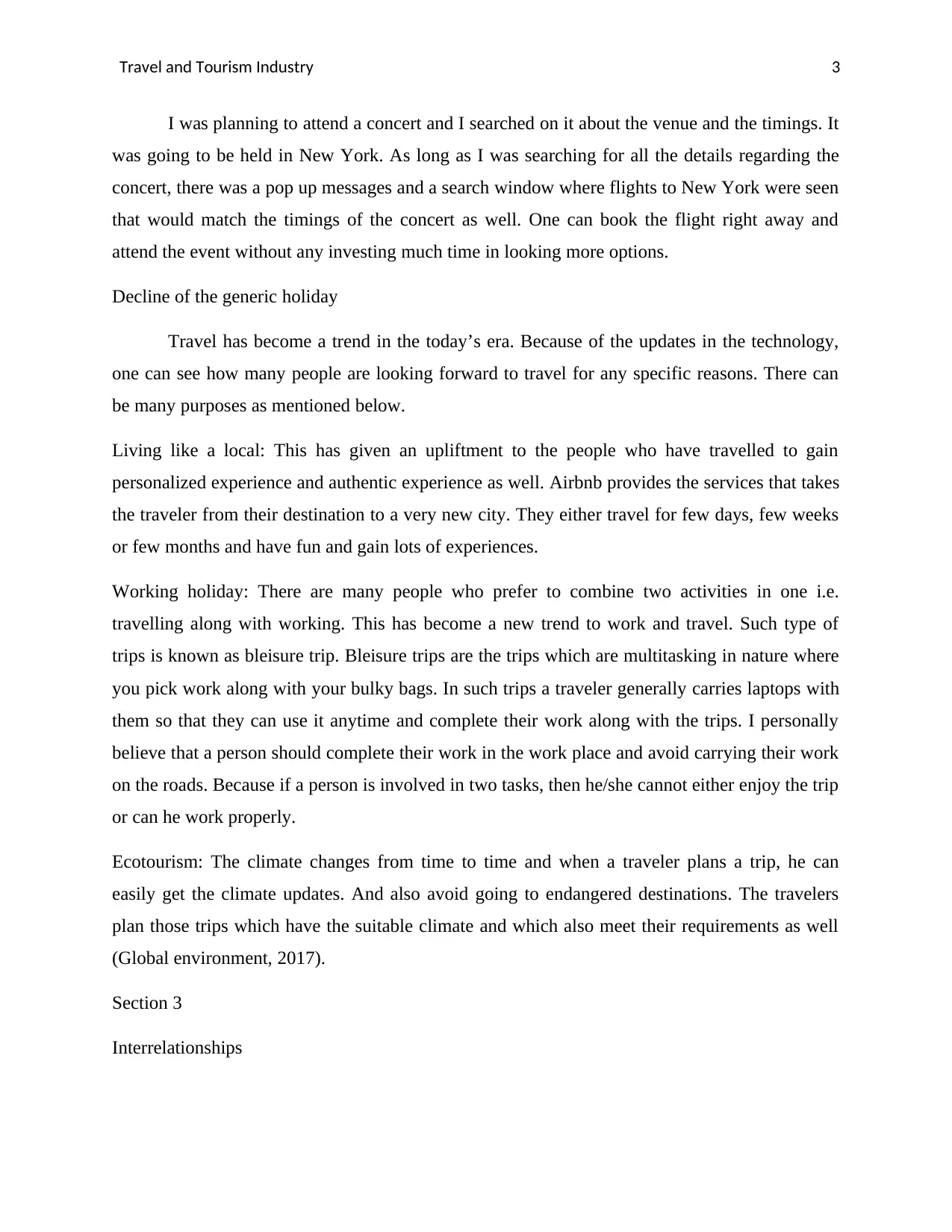
Travel and Tourism Industry 3
I was planning to attend a concert and I searched on it about the venue and the timings. It
was going to be held in New York. As long as I was searching for all the details regarding the
concert, there was a pop up messages and a search window where flights to New York were seen
that would match the timings of the concert as well. One can book the flight right away and
attend the event without any investing much time in looking more options.
Decline of the generic holiday
Travel has become a trend in the today’s era. Because of the updates in the technology,
one can see how many people are looking forward to travel for any specific reasons. There can
be many purposes as mentioned below.
Living like a local: This has given an upliftment to the people who have travelled to gain
personalized experience and authentic experience as well. Airbnb provides the services that takes
the traveler from their destination to a very new city. They either travel for few days, few weeks
or few months and have fun and gain lots of experiences.
Working holiday: There are many people who prefer to combine two activities in one i.e.
travelling along with working. This has become a new trend to work and travel. Such type of
trips is known as bleisure trip. Bleisure trips are the trips which are multitasking in nature where
you pick work along with your bulky bags. In such trips a traveler generally carries laptops with
them so that they can use it anytime and complete their work along with the trips. I personally
believe that a person should complete their work in the work place and avoid carrying their work
on the roads. Because if a person is involved in two tasks, then he/she cannot either enjoy the trip
or can he work properly.
Ecotourism: The climate changes from time to time and when a traveler plans a trip, he can
easily get the climate updates. And also avoid going to endangered destinations. The travelers
plan those trips which have the suitable climate and which also meet their requirements as well
(Global environment, 2017).
Section 3
Interrelationships
I was planning to attend a concert and I searched on it about the venue and the timings. It
was going to be held in New York. As long as I was searching for all the details regarding the
concert, there was a pop up messages and a search window where flights to New York were seen
that would match the timings of the concert as well. One can book the flight right away and
attend the event without any investing much time in looking more options.
Decline of the generic holiday
Travel has become a trend in the today’s era. Because of the updates in the technology,
one can see how many people are looking forward to travel for any specific reasons. There can
be many purposes as mentioned below.
Living like a local: This has given an upliftment to the people who have travelled to gain
personalized experience and authentic experience as well. Airbnb provides the services that takes
the traveler from their destination to a very new city. They either travel for few days, few weeks
or few months and have fun and gain lots of experiences.
Working holiday: There are many people who prefer to combine two activities in one i.e.
travelling along with working. This has become a new trend to work and travel. Such type of
trips is known as bleisure trip. Bleisure trips are the trips which are multitasking in nature where
you pick work along with your bulky bags. In such trips a traveler generally carries laptops with
them so that they can use it anytime and complete their work along with the trips. I personally
believe that a person should complete their work in the work place and avoid carrying their work
on the roads. Because if a person is involved in two tasks, then he/she cannot either enjoy the trip
or can he work properly.
Ecotourism: The climate changes from time to time and when a traveler plans a trip, he can
easily get the climate updates. And also avoid going to endangered destinations. The travelers
plan those trips which have the suitable climate and which also meet their requirements as well
(Global environment, 2017).
Section 3
Interrelationships
Paraphrase This Document
Need a fresh take? Get an instant paraphrase of this document with our AI Paraphraser
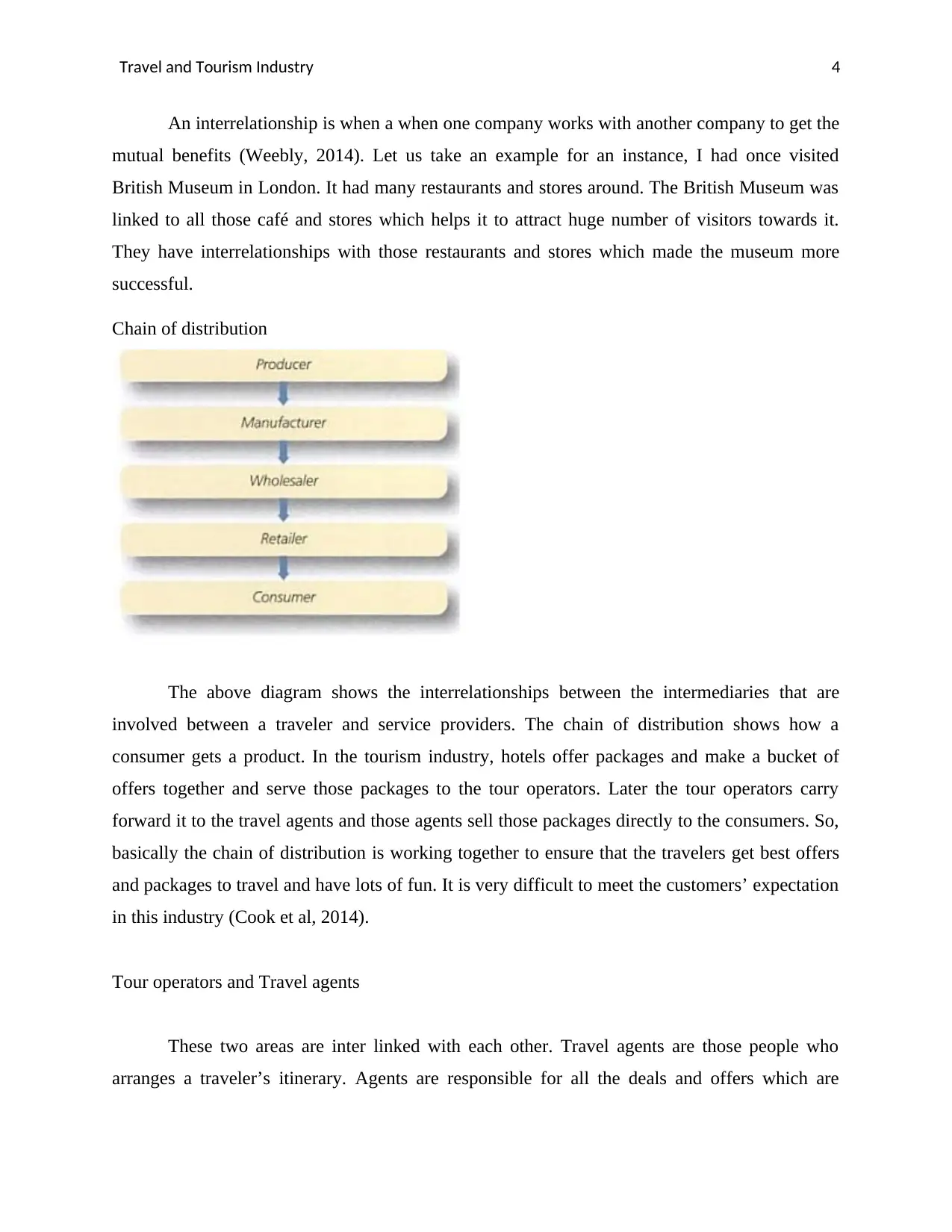
Travel and Tourism Industry 4
An interrelationship is when a when one company works with another company to get the
mutual benefits (Weebly, 2014). Let us take an example for an instance, I had once visited
British Museum in London. It had many restaurants and stores around. The British Museum was
linked to all those café and stores which helps it to attract huge number of visitors towards it.
They have interrelationships with those restaurants and stores which made the museum more
successful.
Chain of distribution
The above diagram shows the interrelationships between the intermediaries that are
involved between a traveler and service providers. The chain of distribution shows how a
consumer gets a product. In the tourism industry, hotels offer packages and make a bucket of
offers together and serve those packages to the tour operators. Later the tour operators carry
forward it to the travel agents and those agents sell those packages directly to the consumers. So,
basically the chain of distribution is working together to ensure that the travelers get best offers
and packages to travel and have lots of fun. It is very difficult to meet the customers’ expectation
in this industry (Cook et al, 2014).
Tour operators and Travel agents
These two areas are inter linked with each other. Travel agents are those people who
arranges a traveler’s itinerary. Agents are responsible for all the deals and offers which are
An interrelationship is when a when one company works with another company to get the
mutual benefits (Weebly, 2014). Let us take an example for an instance, I had once visited
British Museum in London. It had many restaurants and stores around. The British Museum was
linked to all those café and stores which helps it to attract huge number of visitors towards it.
They have interrelationships with those restaurants and stores which made the museum more
successful.
Chain of distribution
The above diagram shows the interrelationships between the intermediaries that are
involved between a traveler and service providers. The chain of distribution shows how a
consumer gets a product. In the tourism industry, hotels offer packages and make a bucket of
offers together and serve those packages to the tour operators. Later the tour operators carry
forward it to the travel agents and those agents sell those packages directly to the consumers. So,
basically the chain of distribution is working together to ensure that the travelers get best offers
and packages to travel and have lots of fun. It is very difficult to meet the customers’ expectation
in this industry (Cook et al, 2014).
Tour operators and Travel agents
These two areas are inter linked with each other. Travel agents are those people who
arranges a traveler’s itinerary. Agents are responsible for all the deals and offers which are
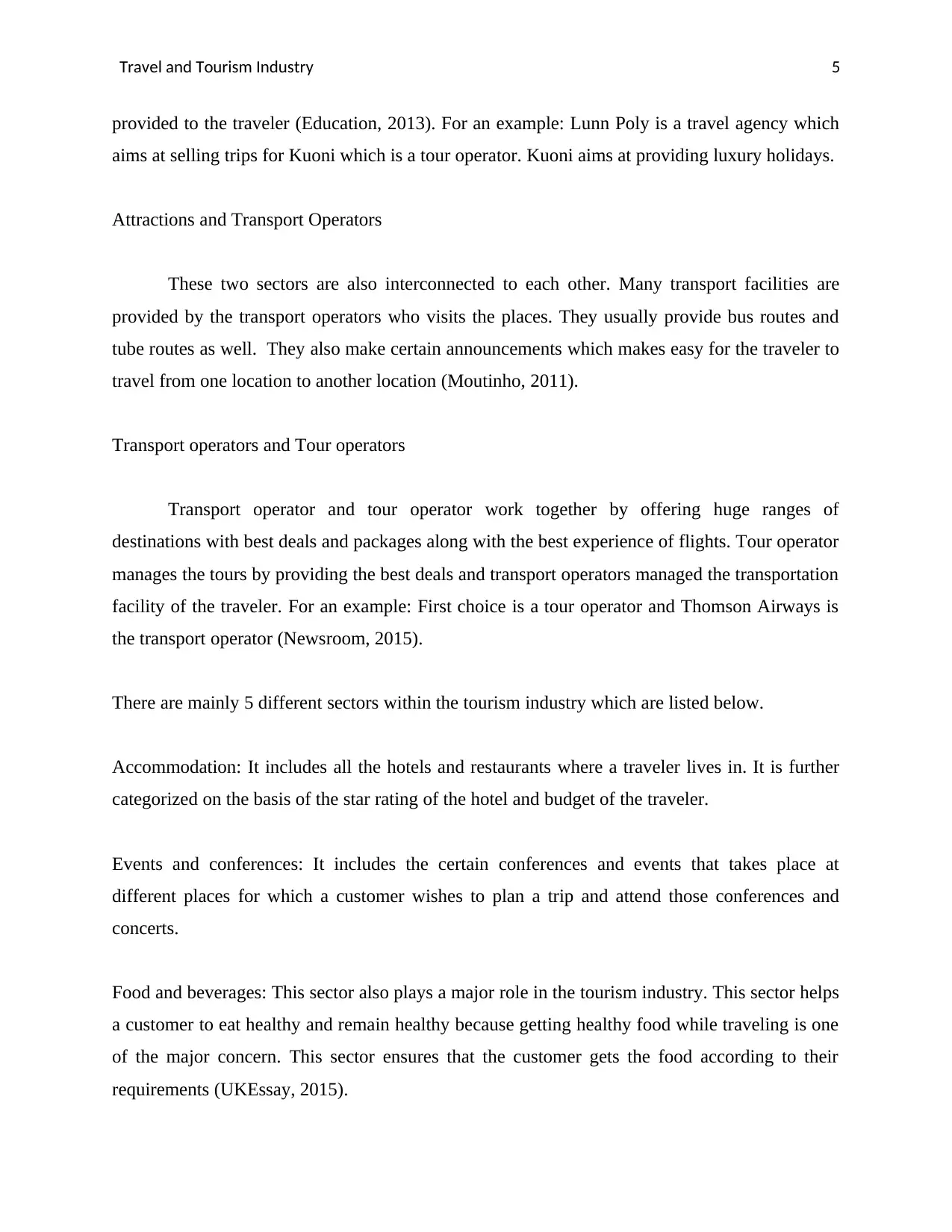
Travel and Tourism Industry 5
provided to the traveler (Education, 2013). For an example: Lunn Poly is a travel agency which
aims at selling trips for Kuoni which is a tour operator. Kuoni aims at providing luxury holidays.
Attractions and Transport Operators
These two sectors are also interconnected to each other. Many transport facilities are
provided by the transport operators who visits the places. They usually provide bus routes and
tube routes as well. They also make certain announcements which makes easy for the traveler to
travel from one location to another location (Moutinho, 2011).
Transport operators and Tour operators
Transport operator and tour operator work together by offering huge ranges of
destinations with best deals and packages along with the best experience of flights. Tour operator
manages the tours by providing the best deals and transport operators managed the transportation
facility of the traveler. For an example: First choice is a tour operator and Thomson Airways is
the transport operator (Newsroom, 2015).
There are mainly 5 different sectors within the tourism industry which are listed below.
Accommodation: It includes all the hotels and restaurants where a traveler lives in. It is further
categorized on the basis of the star rating of the hotel and budget of the traveler.
Events and conferences: It includes the certain conferences and events that takes place at
different places for which a customer wishes to plan a trip and attend those conferences and
concerts.
Food and beverages: This sector also plays a major role in the tourism industry. This sector helps
a customer to eat healthy and remain healthy because getting healthy food while traveling is one
of the major concern. This sector ensures that the customer gets the food according to their
requirements (UKEssay, 2015).
provided to the traveler (Education, 2013). For an example: Lunn Poly is a travel agency which
aims at selling trips for Kuoni which is a tour operator. Kuoni aims at providing luxury holidays.
Attractions and Transport Operators
These two sectors are also interconnected to each other. Many transport facilities are
provided by the transport operators who visits the places. They usually provide bus routes and
tube routes as well. They also make certain announcements which makes easy for the traveler to
travel from one location to another location (Moutinho, 2011).
Transport operators and Tour operators
Transport operator and tour operator work together by offering huge ranges of
destinations with best deals and packages along with the best experience of flights. Tour operator
manages the tours by providing the best deals and transport operators managed the transportation
facility of the traveler. For an example: First choice is a tour operator and Thomson Airways is
the transport operator (Newsroom, 2015).
There are mainly 5 different sectors within the tourism industry which are listed below.
Accommodation: It includes all the hotels and restaurants where a traveler lives in. It is further
categorized on the basis of the star rating of the hotel and budget of the traveler.
Events and conferences: It includes the certain conferences and events that takes place at
different places for which a customer wishes to plan a trip and attend those conferences and
concerts.
Food and beverages: This sector also plays a major role in the tourism industry. This sector helps
a customer to eat healthy and remain healthy because getting healthy food while traveling is one
of the major concern. This sector ensures that the customer gets the food according to their
requirements (UKEssay, 2015).
⊘ This is a preview!⊘
Do you want full access?
Subscribe today to unlock all pages.

Trusted by 1+ million students worldwide
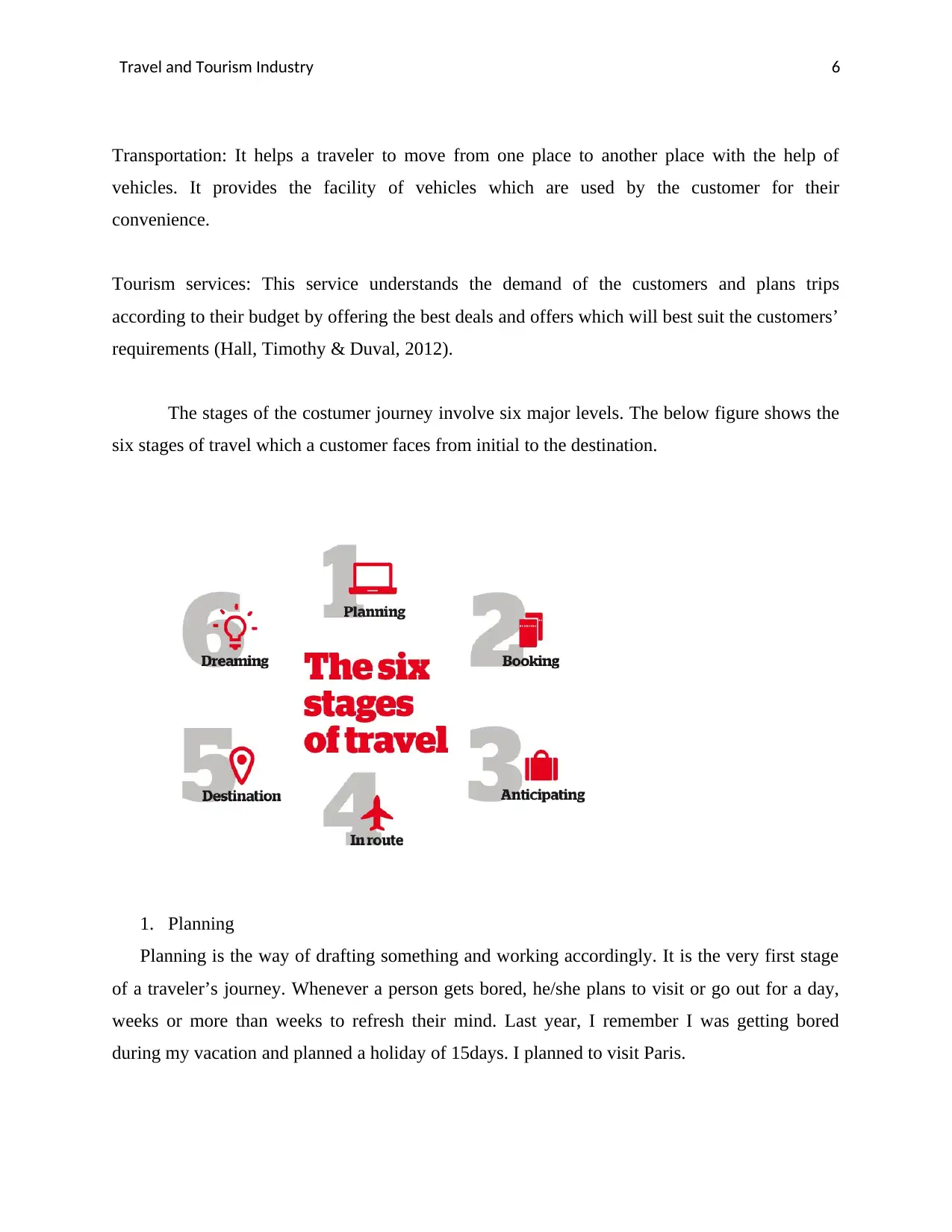
Travel and Tourism Industry 6
Transportation: It helps a traveler to move from one place to another place with the help of
vehicles. It provides the facility of vehicles which are used by the customer for their
convenience.
Tourism services: This service understands the demand of the customers and plans trips
according to their budget by offering the best deals and offers which will best suit the customers’
requirements (Hall, Timothy & Duval, 2012).
The stages of the costumer journey involve six major levels. The below figure shows the
six stages of travel which a customer faces from initial to the destination.
1. Planning
Planning is the way of drafting something and working accordingly. It is the very first stage
of a traveler’s journey. Whenever a person gets bored, he/she plans to visit or go out for a day,
weeks or more than weeks to refresh their mind. Last year, I remember I was getting bored
during my vacation and planned a holiday of 15days. I planned to visit Paris.
Transportation: It helps a traveler to move from one place to another place with the help of
vehicles. It provides the facility of vehicles which are used by the customer for their
convenience.
Tourism services: This service understands the demand of the customers and plans trips
according to their budget by offering the best deals and offers which will best suit the customers’
requirements (Hall, Timothy & Duval, 2012).
The stages of the costumer journey involve six major levels. The below figure shows the
six stages of travel which a customer faces from initial to the destination.
1. Planning
Planning is the way of drafting something and working accordingly. It is the very first stage
of a traveler’s journey. Whenever a person gets bored, he/she plans to visit or go out for a day,
weeks or more than weeks to refresh their mind. Last year, I remember I was getting bored
during my vacation and planned a holiday of 15days. I planned to visit Paris.
Paraphrase This Document
Need a fresh take? Get an instant paraphrase of this document with our AI Paraphraser
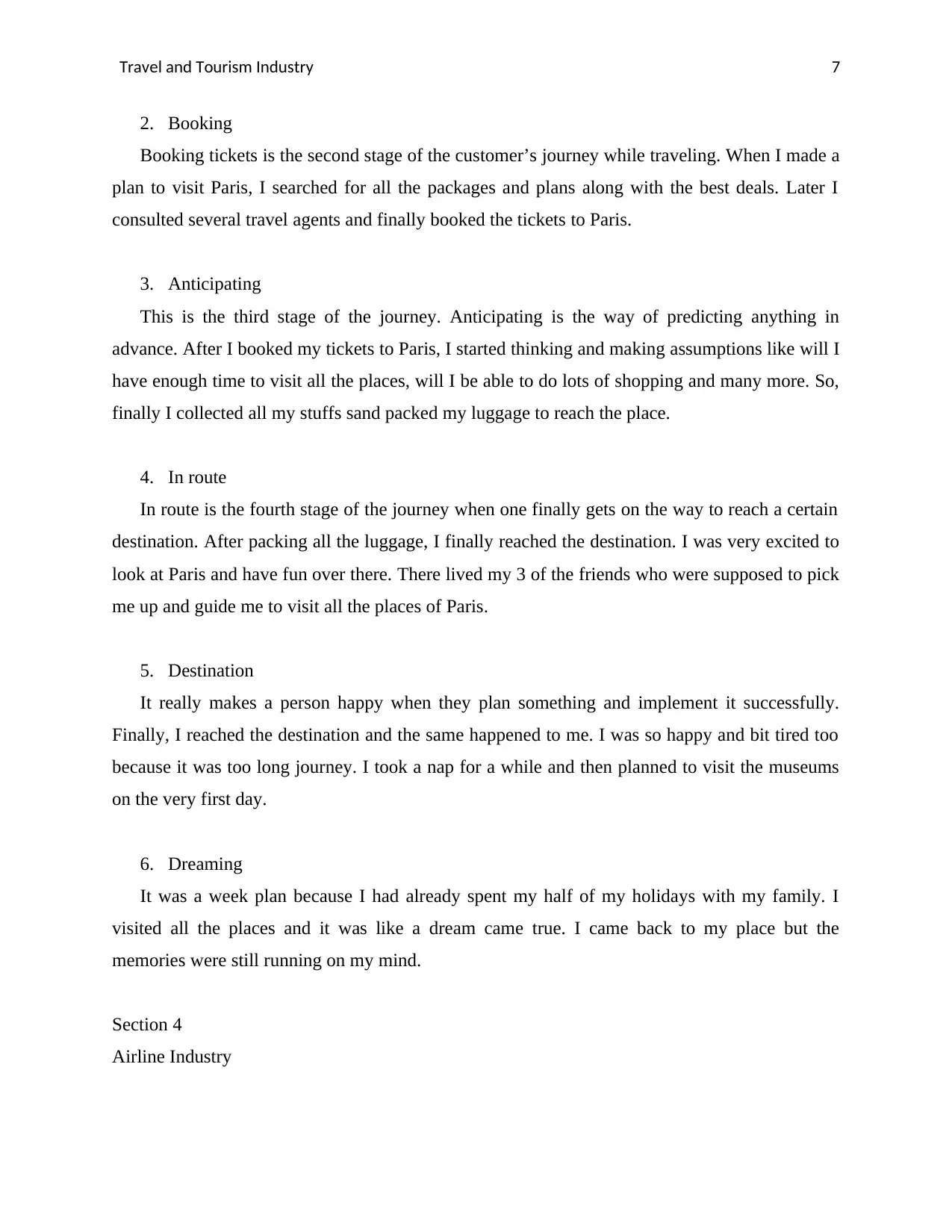
Travel and Tourism Industry 7
2. Booking
Booking tickets is the second stage of the customer’s journey while traveling. When I made a
plan to visit Paris, I searched for all the packages and plans along with the best deals. Later I
consulted several travel agents and finally booked the tickets to Paris.
3. Anticipating
This is the third stage of the journey. Anticipating is the way of predicting anything in
advance. After I booked my tickets to Paris, I started thinking and making assumptions like will I
have enough time to visit all the places, will I be able to do lots of shopping and many more. So,
finally I collected all my stuffs sand packed my luggage to reach the place.
4. In route
In route is the fourth stage of the journey when one finally gets on the way to reach a certain
destination. After packing all the luggage, I finally reached the destination. I was very excited to
look at Paris and have fun over there. There lived my 3 of the friends who were supposed to pick
me up and guide me to visit all the places of Paris.
5. Destination
It really makes a person happy when they plan something and implement it successfully.
Finally, I reached the destination and the same happened to me. I was so happy and bit tired too
because it was too long journey. I took a nap for a while and then planned to visit the museums
on the very first day.
6. Dreaming
It was a week plan because I had already spent my half of my holidays with my family. I
visited all the places and it was like a dream came true. I came back to my place but the
memories were still running on my mind.
Section 4
Airline Industry
2. Booking
Booking tickets is the second stage of the customer’s journey while traveling. When I made a
plan to visit Paris, I searched for all the packages and plans along with the best deals. Later I
consulted several travel agents and finally booked the tickets to Paris.
3. Anticipating
This is the third stage of the journey. Anticipating is the way of predicting anything in
advance. After I booked my tickets to Paris, I started thinking and making assumptions like will I
have enough time to visit all the places, will I be able to do lots of shopping and many more. So,
finally I collected all my stuffs sand packed my luggage to reach the place.
4. In route
In route is the fourth stage of the journey when one finally gets on the way to reach a certain
destination. After packing all the luggage, I finally reached the destination. I was very excited to
look at Paris and have fun over there. There lived my 3 of the friends who were supposed to pick
me up and guide me to visit all the places of Paris.
5. Destination
It really makes a person happy when they plan something and implement it successfully.
Finally, I reached the destination and the same happened to me. I was so happy and bit tired too
because it was too long journey. I took a nap for a while and then planned to visit the museums
on the very first day.
6. Dreaming
It was a week plan because I had already spent my half of my holidays with my family. I
visited all the places and it was like a dream came true. I came back to my place but the
memories were still running on my mind.
Section 4
Airline Industry
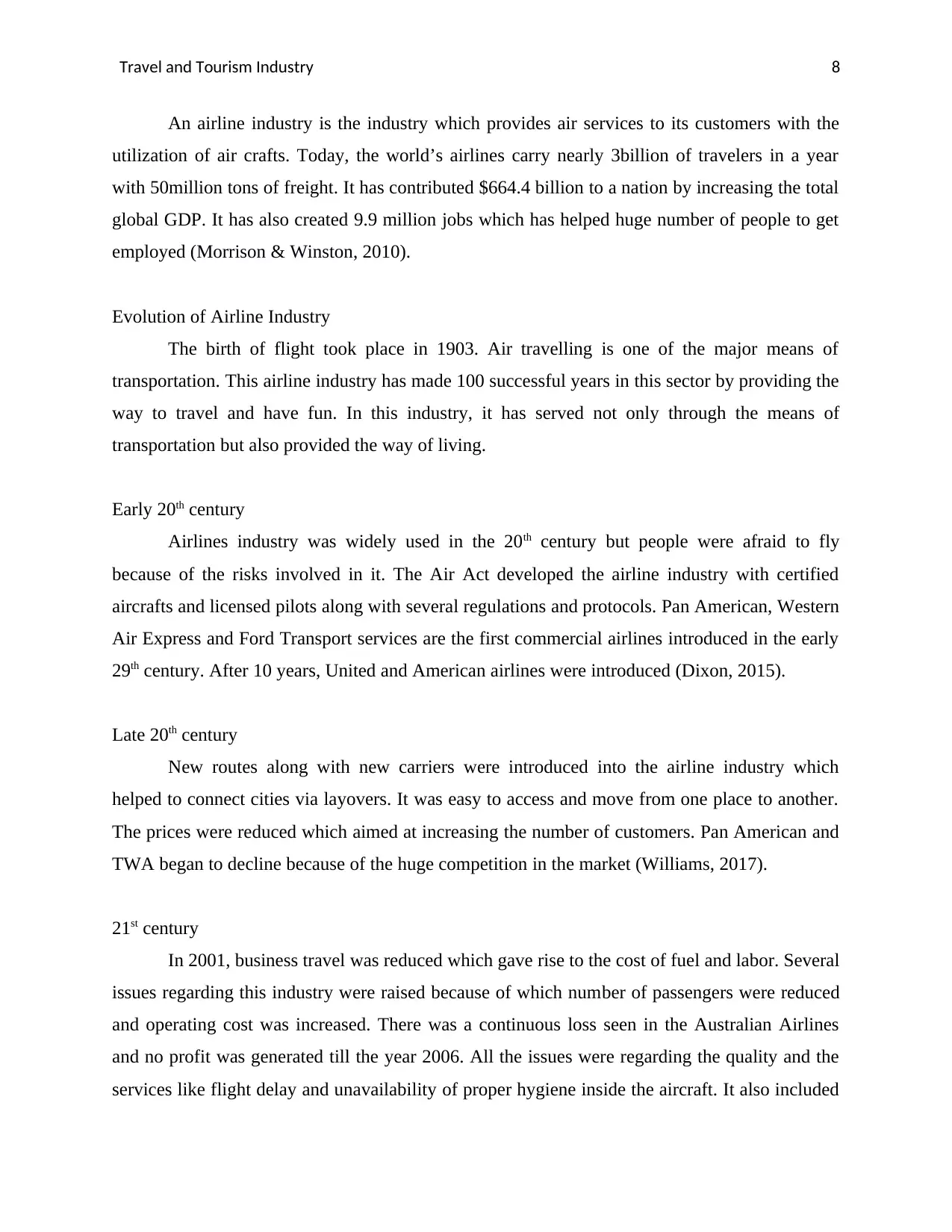
Travel and Tourism Industry 8
An airline industry is the industry which provides air services to its customers with the
utilization of air crafts. Today, the world’s airlines carry nearly 3billion of travelers in a year
with 50million tons of freight. It has contributed $664.4 billion to a nation by increasing the total
global GDP. It has also created 9.9 million jobs which has helped huge number of people to get
employed (Morrison & Winston, 2010).
Evolution of Airline Industry
The birth of flight took place in 1903. Air travelling is one of the major means of
transportation. This airline industry has made 100 successful years in this sector by providing the
way to travel and have fun. In this industry, it has served not only through the means of
transportation but also provided the way of living.
Early 20th century
Airlines industry was widely used in the 20th century but people were afraid to fly
because of the risks involved in it. The Air Act developed the airline industry with certified
aircrafts and licensed pilots along with several regulations and protocols. Pan American, Western
Air Express and Ford Transport services are the first commercial airlines introduced in the early
29th century. After 10 years, United and American airlines were introduced (Dixon, 2015).
Late 20th century
New routes along with new carriers were introduced into the airline industry which
helped to connect cities via layovers. It was easy to access and move from one place to another.
The prices were reduced which aimed at increasing the number of customers. Pan American and
TWA began to decline because of the huge competition in the market (Williams, 2017).
21st century
In 2001, business travel was reduced which gave rise to the cost of fuel and labor. Several
issues regarding this industry were raised because of which number of passengers were reduced
and operating cost was increased. There was a continuous loss seen in the Australian Airlines
and no profit was generated till the year 2006. All the issues were regarding the quality and the
services like flight delay and unavailability of proper hygiene inside the aircraft. It also included
An airline industry is the industry which provides air services to its customers with the
utilization of air crafts. Today, the world’s airlines carry nearly 3billion of travelers in a year
with 50million tons of freight. It has contributed $664.4 billion to a nation by increasing the total
global GDP. It has also created 9.9 million jobs which has helped huge number of people to get
employed (Morrison & Winston, 2010).
Evolution of Airline Industry
The birth of flight took place in 1903. Air travelling is one of the major means of
transportation. This airline industry has made 100 successful years in this sector by providing the
way to travel and have fun. In this industry, it has served not only through the means of
transportation but also provided the way of living.
Early 20th century
Airlines industry was widely used in the 20th century but people were afraid to fly
because of the risks involved in it. The Air Act developed the airline industry with certified
aircrafts and licensed pilots along with several regulations and protocols. Pan American, Western
Air Express and Ford Transport services are the first commercial airlines introduced in the early
29th century. After 10 years, United and American airlines were introduced (Dixon, 2015).
Late 20th century
New routes along with new carriers were introduced into the airline industry which
helped to connect cities via layovers. It was easy to access and move from one place to another.
The prices were reduced which aimed at increasing the number of customers. Pan American and
TWA began to decline because of the huge competition in the market (Williams, 2017).
21st century
In 2001, business travel was reduced which gave rise to the cost of fuel and labor. Several
issues regarding this industry were raised because of which number of passengers were reduced
and operating cost was increased. There was a continuous loss seen in the Australian Airlines
and no profit was generated till the year 2006. All the issues were regarding the quality and the
services like flight delay and unavailability of proper hygiene inside the aircraft. It also included
⊘ This is a preview!⊘
Do you want full access?
Subscribe today to unlock all pages.

Trusted by 1+ million students worldwide
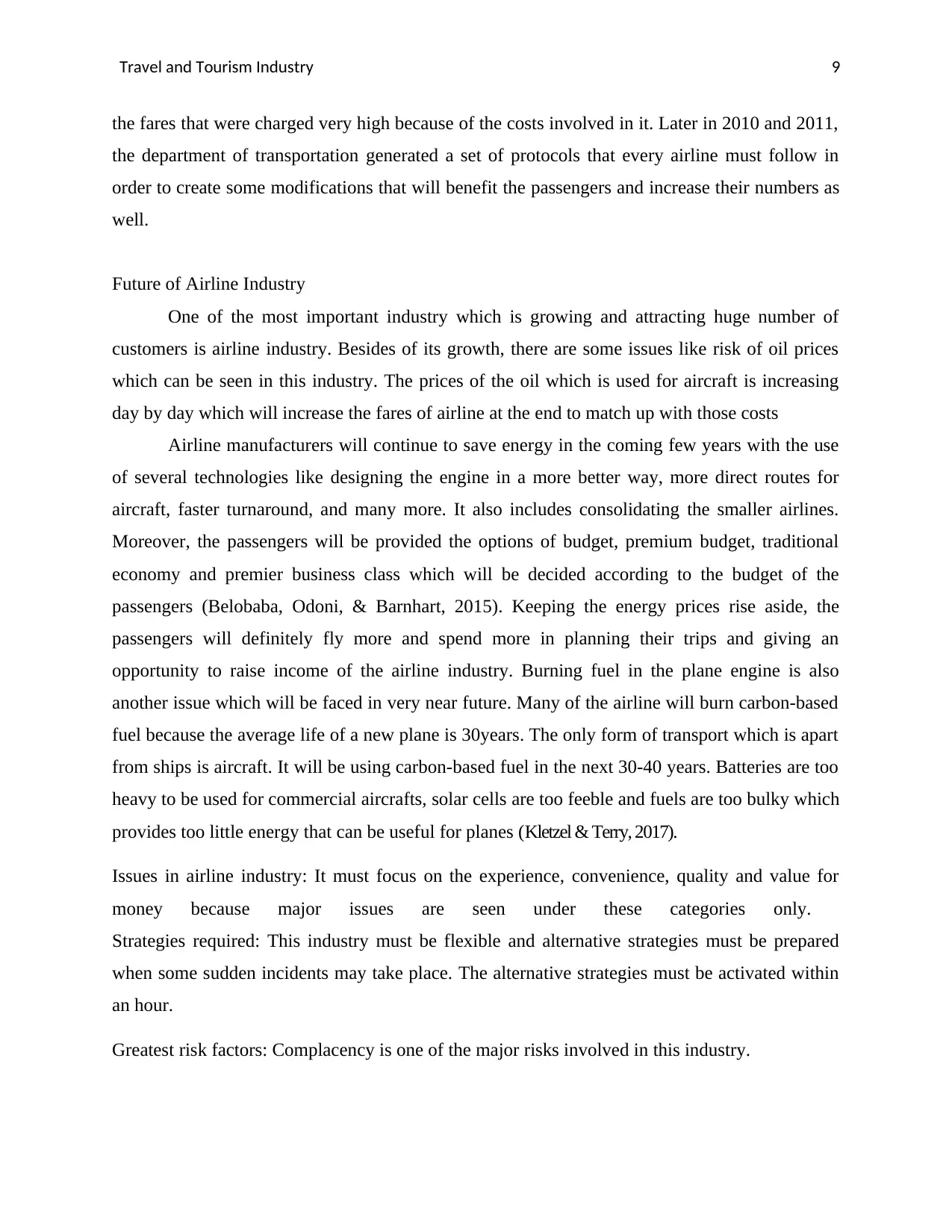
Travel and Tourism Industry 9
the fares that were charged very high because of the costs involved in it. Later in 2010 and 2011,
the department of transportation generated a set of protocols that every airline must follow in
order to create some modifications that will benefit the passengers and increase their numbers as
well.
Future of Airline Industry
One of the most important industry which is growing and attracting huge number of
customers is airline industry. Besides of its growth, there are some issues like risk of oil prices
which can be seen in this industry. The prices of the oil which is used for aircraft is increasing
day by day which will increase the fares of airline at the end to match up with those costs
Airline manufacturers will continue to save energy in the coming few years with the use
of several technologies like designing the engine in a more better way, more direct routes for
aircraft, faster turnaround, and many more. It also includes consolidating the smaller airlines.
Moreover, the passengers will be provided the options of budget, premium budget, traditional
economy and premier business class which will be decided according to the budget of the
passengers (Belobaba, Odoni, & Barnhart, 2015). Keeping the energy prices rise aside, the
passengers will definitely fly more and spend more in planning their trips and giving an
opportunity to raise income of the airline industry. Burning fuel in the plane engine is also
another issue which will be faced in very near future. Many of the airline will burn carbon-based
fuel because the average life of a new plane is 30years. The only form of transport which is apart
from ships is aircraft. It will be using carbon-based fuel in the next 30-40 years. Batteries are too
heavy to be used for commercial aircrafts, solar cells are too feeble and fuels are too bulky which
provides too little energy that can be useful for planes (Kletzel & Terry, 2017).
Issues in airline industry: It must focus on the experience, convenience, quality and value for
money because major issues are seen under these categories only.
Strategies required: This industry must be flexible and alternative strategies must be prepared
when some sudden incidents may take place. The alternative strategies must be activated within
an hour.
Greatest risk factors: Complacency is one of the major risks involved in this industry.
the fares that were charged very high because of the costs involved in it. Later in 2010 and 2011,
the department of transportation generated a set of protocols that every airline must follow in
order to create some modifications that will benefit the passengers and increase their numbers as
well.
Future of Airline Industry
One of the most important industry which is growing and attracting huge number of
customers is airline industry. Besides of its growth, there are some issues like risk of oil prices
which can be seen in this industry. The prices of the oil which is used for aircraft is increasing
day by day which will increase the fares of airline at the end to match up with those costs
Airline manufacturers will continue to save energy in the coming few years with the use
of several technologies like designing the engine in a more better way, more direct routes for
aircraft, faster turnaround, and many more. It also includes consolidating the smaller airlines.
Moreover, the passengers will be provided the options of budget, premium budget, traditional
economy and premier business class which will be decided according to the budget of the
passengers (Belobaba, Odoni, & Barnhart, 2015). Keeping the energy prices rise aside, the
passengers will definitely fly more and spend more in planning their trips and giving an
opportunity to raise income of the airline industry. Burning fuel in the plane engine is also
another issue which will be faced in very near future. Many of the airline will burn carbon-based
fuel because the average life of a new plane is 30years. The only form of transport which is apart
from ships is aircraft. It will be using carbon-based fuel in the next 30-40 years. Batteries are too
heavy to be used for commercial aircrafts, solar cells are too feeble and fuels are too bulky which
provides too little energy that can be useful for planes (Kletzel & Terry, 2017).
Issues in airline industry: It must focus on the experience, convenience, quality and value for
money because major issues are seen under these categories only.
Strategies required: This industry must be flexible and alternative strategies must be prepared
when some sudden incidents may take place. The alternative strategies must be activated within
an hour.
Greatest risk factors: Complacency is one of the major risks involved in this industry.
Paraphrase This Document
Need a fresh take? Get an instant paraphrase of this document with our AI Paraphraser
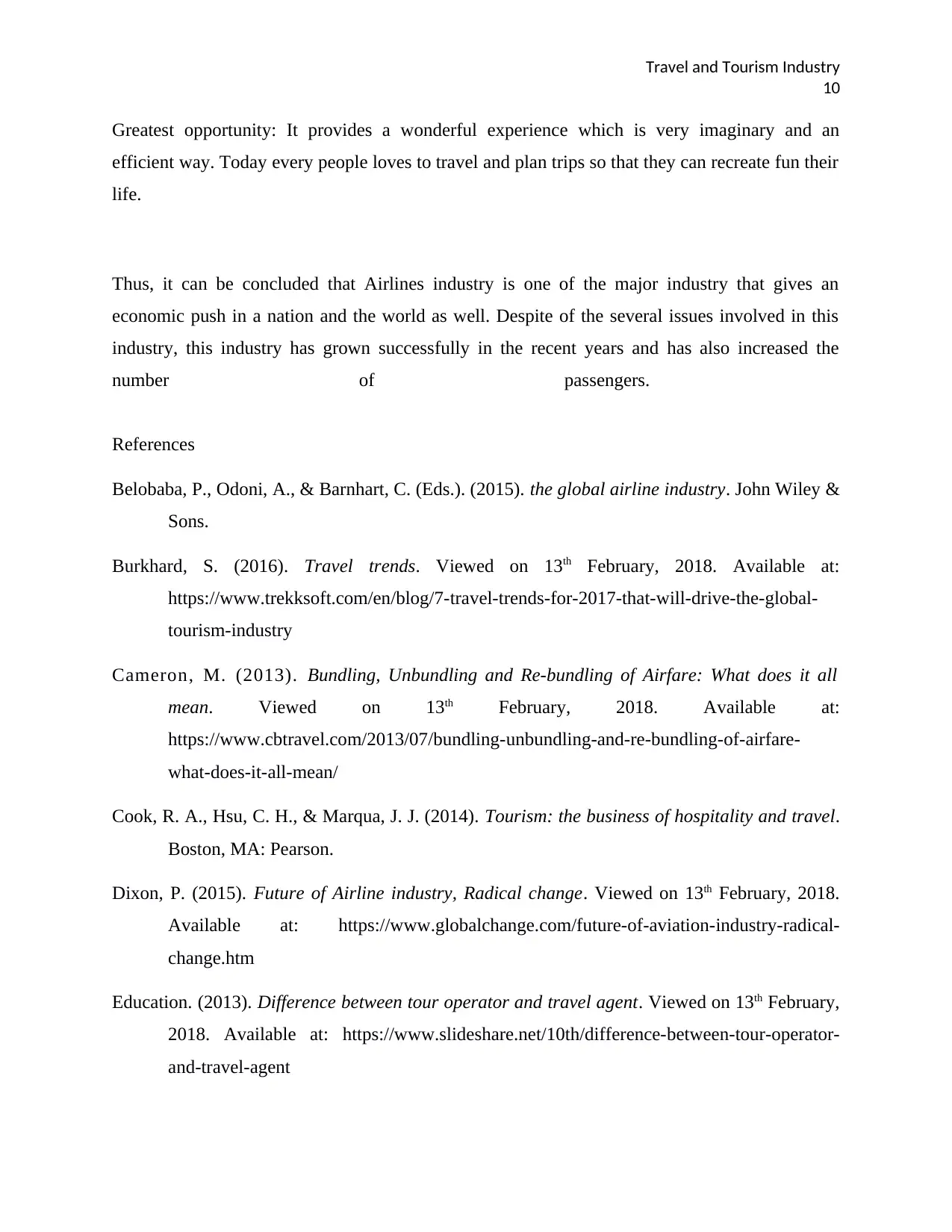
Travel and Tourism Industry
10
Greatest opportunity: It provides a wonderful experience which is very imaginary and an
efficient way. Today every people loves to travel and plan trips so that they can recreate fun their
life.
Thus, it can be concluded that Airlines industry is one of the major industry that gives an
economic push in a nation and the world as well. Despite of the several issues involved in this
industry, this industry has grown successfully in the recent years and has also increased the
number of passengers.
References
Belobaba, P., Odoni, A., & Barnhart, C. (Eds.). (2015). the global airline industry. John Wiley &
Sons.
Burkhard, S. (2016). Travel trends. Viewed on 13th February, 2018. Available at:
https://www.trekksoft.com/en/blog/7-travel-trends-for-2017-that-will-drive-the-global-
tourism-industry
Cameron, M. (2013). Bundling, Unbundling and Re-bundling of Airfare: What does it all
mean. Viewed on 13th February, 2018. Available at:
https://www.cbtravel.com/2013/07/bundling-unbundling-and-re-bundling-of-airfare-
what-does-it-all-mean/
Cook, R. A., Hsu, C. H., & Marqua, J. J. (2014). Tourism: the business of hospitality and travel.
Boston, MA: Pearson.
Dixon, P. (2015). Future of Airline industry, Radical change. Viewed on 13th February, 2018.
Available at: https://www.globalchange.com/future-of-aviation-industry-radical-
change.htm
Education. (2013). Difference between tour operator and travel agent. Viewed on 13th February,
2018. Available at: https://www.slideshare.net/10th/difference-between-tour-operator-
and-travel-agent
10
Greatest opportunity: It provides a wonderful experience which is very imaginary and an
efficient way. Today every people loves to travel and plan trips so that they can recreate fun their
life.
Thus, it can be concluded that Airlines industry is one of the major industry that gives an
economic push in a nation and the world as well. Despite of the several issues involved in this
industry, this industry has grown successfully in the recent years and has also increased the
number of passengers.
References
Belobaba, P., Odoni, A., & Barnhart, C. (Eds.). (2015). the global airline industry. John Wiley &
Sons.
Burkhard, S. (2016). Travel trends. Viewed on 13th February, 2018. Available at:
https://www.trekksoft.com/en/blog/7-travel-trends-for-2017-that-will-drive-the-global-
tourism-industry
Cameron, M. (2013). Bundling, Unbundling and Re-bundling of Airfare: What does it all
mean. Viewed on 13th February, 2018. Available at:
https://www.cbtravel.com/2013/07/bundling-unbundling-and-re-bundling-of-airfare-
what-does-it-all-mean/
Cook, R. A., Hsu, C. H., & Marqua, J. J. (2014). Tourism: the business of hospitality and travel.
Boston, MA: Pearson.
Dixon, P. (2015). Future of Airline industry, Radical change. Viewed on 13th February, 2018.
Available at: https://www.globalchange.com/future-of-aviation-industry-radical-
change.htm
Education. (2013). Difference between tour operator and travel agent. Viewed on 13th February,
2018. Available at: https://www.slideshare.net/10th/difference-between-tour-operator-
and-travel-agent
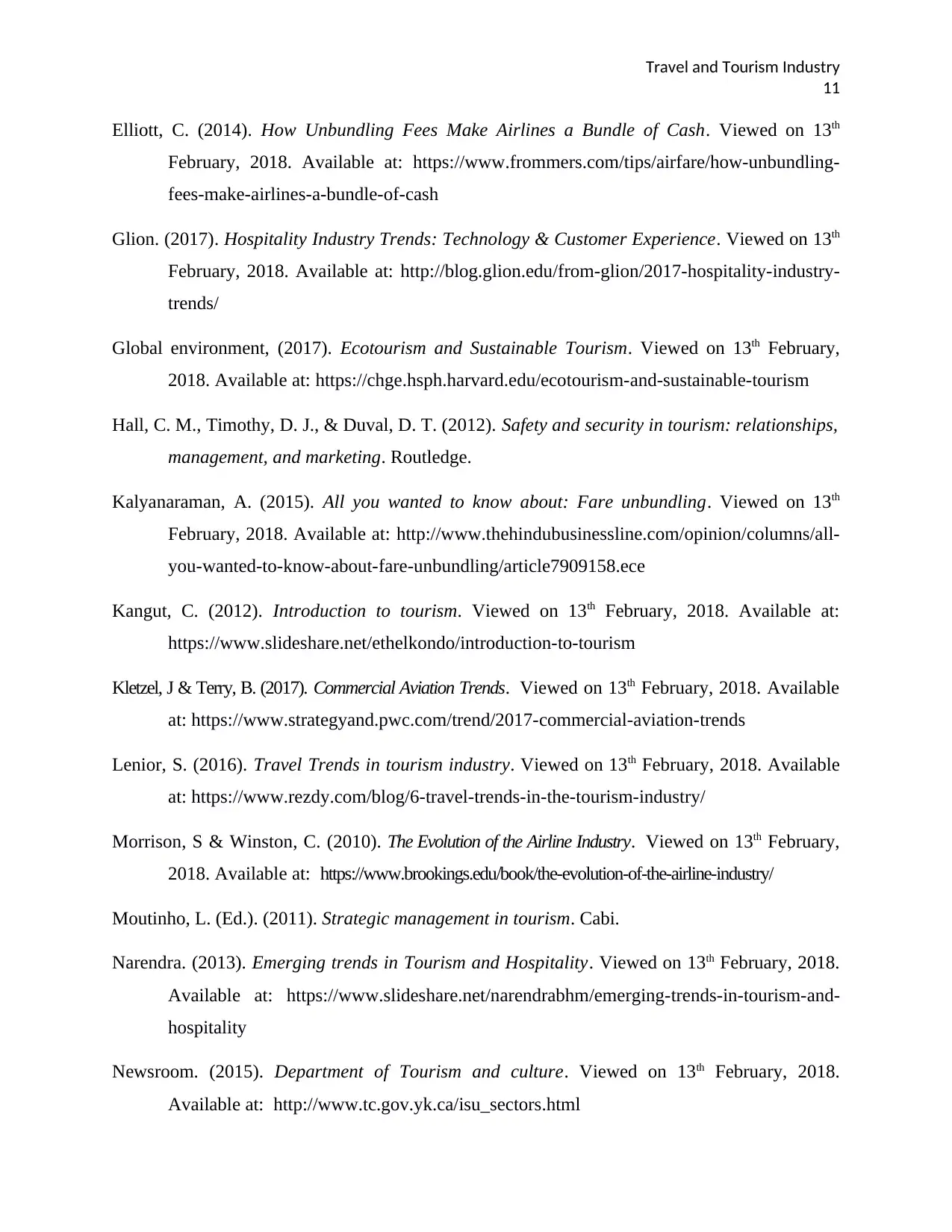
Travel and Tourism Industry
11
Elliott, C. (2014). How Unbundling Fees Make Airlines a Bundle of Cash. Viewed on 13th
February, 2018. Available at: https://www.frommers.com/tips/airfare/how-unbundling-
fees-make-airlines-a-bundle-of-cash
Glion. (2017). Hospitality Industry Trends: Technology & Customer Experience. Viewed on 13th
February, 2018. Available at: http://blog.glion.edu/from-glion/2017-hospitality-industry-
trends/
Global environment, (2017). Ecotourism and Sustainable Tourism. Viewed on 13th February,
2018. Available at: https://chge.hsph.harvard.edu/ecotourism-and-sustainable-tourism
Hall, C. M., Timothy, D. J., & Duval, D. T. (2012). Safety and security in tourism: relationships,
management, and marketing. Routledge.
Kalyanaraman, A. (2015). All you wanted to know about: Fare unbundling. Viewed on 13th
February, 2018. Available at: http://www.thehindubusinessline.com/opinion/columns/all-
you-wanted-to-know-about-fare-unbundling/article7909158.ece
Kangut, C. (2012). Introduction to tourism. Viewed on 13th February, 2018. Available at:
https://www.slideshare.net/ethelkondo/introduction-to-tourism
Kletzel, J & Terry, B. (2017). Commercial Aviation Trends. Viewed on 13th February, 2018. Available
at: https://www.strategyand.pwc.com/trend/2017-commercial-aviation-trends
Lenior, S. (2016). Travel Trends in tourism industry. Viewed on 13th February, 2018. Available
at: https://www.rezdy.com/blog/6-travel-trends-in-the-tourism-industry/
Morrison, S & Winston, C. (2010). The Evolution of the Airline Industry. Viewed on 13th February,
2018. Available at: https://www.brookings.edu/book/the-evolution-of-the-airline-industry/
Moutinho, L. (Ed.). (2011). Strategic management in tourism. Cabi.
Narendra. (2013). Emerging trends in Tourism and Hospitality. Viewed on 13th February, 2018.
Available at: https://www.slideshare.net/narendrabhm/emerging-trends-in-tourism-and-
hospitality
Newsroom. (2015). Department of Tourism and culture. Viewed on 13th February, 2018.
Available at: http://www.tc.gov.yk.ca/isu_sectors.html
11
Elliott, C. (2014). How Unbundling Fees Make Airlines a Bundle of Cash. Viewed on 13th
February, 2018. Available at: https://www.frommers.com/tips/airfare/how-unbundling-
fees-make-airlines-a-bundle-of-cash
Glion. (2017). Hospitality Industry Trends: Technology & Customer Experience. Viewed on 13th
February, 2018. Available at: http://blog.glion.edu/from-glion/2017-hospitality-industry-
trends/
Global environment, (2017). Ecotourism and Sustainable Tourism. Viewed on 13th February,
2018. Available at: https://chge.hsph.harvard.edu/ecotourism-and-sustainable-tourism
Hall, C. M., Timothy, D. J., & Duval, D. T. (2012). Safety and security in tourism: relationships,
management, and marketing. Routledge.
Kalyanaraman, A. (2015). All you wanted to know about: Fare unbundling. Viewed on 13th
February, 2018. Available at: http://www.thehindubusinessline.com/opinion/columns/all-
you-wanted-to-know-about-fare-unbundling/article7909158.ece
Kangut, C. (2012). Introduction to tourism. Viewed on 13th February, 2018. Available at:
https://www.slideshare.net/ethelkondo/introduction-to-tourism
Kletzel, J & Terry, B. (2017). Commercial Aviation Trends. Viewed on 13th February, 2018. Available
at: https://www.strategyand.pwc.com/trend/2017-commercial-aviation-trends
Lenior, S. (2016). Travel Trends in tourism industry. Viewed on 13th February, 2018. Available
at: https://www.rezdy.com/blog/6-travel-trends-in-the-tourism-industry/
Morrison, S & Winston, C. (2010). The Evolution of the Airline Industry. Viewed on 13th February,
2018. Available at: https://www.brookings.edu/book/the-evolution-of-the-airline-industry/
Moutinho, L. (Ed.). (2011). Strategic management in tourism. Cabi.
Narendra. (2013). Emerging trends in Tourism and Hospitality. Viewed on 13th February, 2018.
Available at: https://www.slideshare.net/narendrabhm/emerging-trends-in-tourism-and-
hospitality
Newsroom. (2015). Department of Tourism and culture. Viewed on 13th February, 2018.
Available at: http://www.tc.gov.yk.ca/isu_sectors.html
⊘ This is a preview!⊘
Do you want full access?
Subscribe today to unlock all pages.

Trusted by 1+ million students worldwide
1 out of 14
Related Documents
Your All-in-One AI-Powered Toolkit for Academic Success.
+13062052269
info@desklib.com
Available 24*7 on WhatsApp / Email
![[object Object]](/_next/static/media/star-bottom.7253800d.svg)
Unlock your academic potential
Copyright © 2020–2025 A2Z Services. All Rights Reserved. Developed and managed by ZUCOL.




